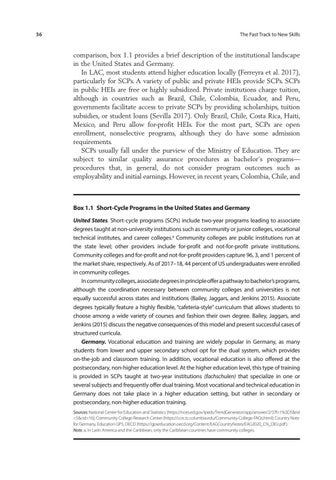36
The Fast Track to New Skills
comparison, box 1.1 provides a brief description of the institutional landscape in the United States and Germany. In LAC, most students attend higher education locally (Ferreyra et al. 2017), particularly for SCPs. A variety of public and private HEIs provide SCPs. SCPs in public HEIs are free or highly subsidized. Private institutions charge tuition, although in countries such as Brazil, Chile, Colombia, Ecuador, and Peru, governments facilitate access to private SCPs by providing scholarships, tuition subsidies, or student loans (Sevilla 2017). Only Brazil, Chile, Costa Rica, Haiti, Mexico, and Peru allow for-profit HEIs. For the most part, SCPs are open enrollment, nonselective programs, although they do have some admission requirements. SCPs usually fall under the purview of the Ministry of Education. They are subject to similar quality assurance procedures as bachelor’s programs— procedures that, in general, do not consider program outcomes such as employability and initial earnings. However, in recent years, Colombia, Chile, and
Box 1.1 Short-Cycle Programs in the United States and Germany United States. Short-cycle programs (SCPs) include two-year programs leading to associate degrees taught at non-university institutions such as community or junior colleges, vocational technical institutes, and career colleges.a Community colleges are public institutions run at the state level; other providers include for-profit and not-for-profit private institutions. Community colleges and for-profit and not-for-profit providers capture 96, 3, and 1 percent of the market share, respectively. As of 2017–18, 44 percent of US undergraduates were enrolled in community colleges. In community colleges, associate degrees in principle offer a pathway to bachelor’s programs, although the coordination necessary between community colleges and universities is not equally successful across states and institutions (Bailey, Jaggars, and Jenkins 2015). Associate degrees typically feature a highly flexible, “cafeteria-style” curriculum that allows students to choose among a wide variety of courses and fashion their own degree. Bailey, Jaggars, and Jenkins (2015) discuss the negative consequences of this model and present successful cases of structured curricula. Germany. Vocational education and training are widely popular in Germany, as many students from lower and upper secondary school opt for the dual system, which provides on-the-job and classroom training. In addition, vocational education is also offered at the postsecondary, non-higher education level. At the higher education level, this type of training is provided in SCPs taught at two-year institutions (fachschulen) that specialize in one or several subjects and frequently offer dual training. Most vocational and technical education in Germany does not take place in a higher education setting, but rather in secondary or postsecondary, non-higher education training. Sources: National Center for Education and Statistics (https://nces.ed.gov/ipeds/TrendGenerator/app/answer/2/3?f=1%3D5&rid =5&cid=16); Community College Research Center (https://ccrc.tc.columbia.edu/Community-College-FAQs.html); Country Note for Germany, Education GPS, OECD (https://gpseducation.oecd.org/Content/EAGCountryNotes/EAG2020_CN_DEU.pdf ). Note. a. In Latin America and the Caribbean, only the Caribbean countries have community colleges.

